Every automaker, no matter how environmentally attuned, has a “no replacement for displacement” crowd in its ranks.
Lexus let their NRFD bunch have some fun, so they shoehorned a 5.0L V8 into a “cutting-edge” rear-wheel-drive two-door coupe. You can now buy it as the 2016 Lexus RC F.
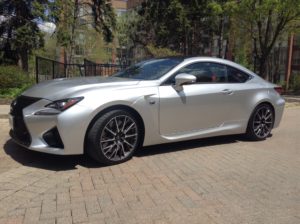
First impressions
I put the words “cutting edge” in parentheses for a reason. My Liquid Platinum (silver) tester features edges just about everywhere you look, from the sharply defined headlights to the air outlets behind the front wheels to the creases on the doors to the tiny fins protruding from the taillights.
Those edges add form to the RC F’s muscular body, which garnered more than a few looks when I drove it in town. Of particular interest is the black lower portion of the RC F’s hindquarters. It makes the silver-coloured body look like it has supports to either side of the car. Four exhaust pipes (two for each side) poke out of the black portion.
Choose the Performance Package, a $7,400 add-on, and Lexus adds details like a carbon fibre roof and carbon fibre speed-activated rear spoiler. The car rides on wide tires held by 19″ forged aluminum wheels that sport an “F” center wheel ornament.
That “F” doesn’t mean “fast” though it does in a roundabout way. It’s “inspired by Fuji Speedway in Japan, where most of our high-speed development takes place,” says Cyril Dimitris, Director of Lexus Canada.
Interior
Circuit Red leather seats catch the eye before you even open the door. Circuit Red leather accents between the seats and on the doors play nicely with carbon fibre and other high-end finishes throughout the cabin.
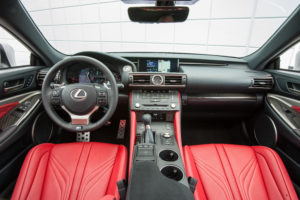
image courtesy Lexus
The sports seats hug your sides, giving you a premonition of the G-forces you might be in for. They also remind you you’re in a Lexus, since they’re both heated and air conditioned. The driver’s seat features seat memory for three drivers.

image courtesy Lexus
The headrests feature the “F” logo, as do many other places in the vehicle.
The power telescoping, leather, heated steering wheel feels chunky and solid in the hands. The wheel retracts when you need to exit the car, and slides back into place when you hit the Start Engine button, conveniently located to the upper right of the instrument cluster.
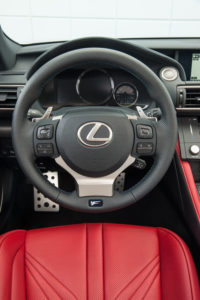
image courtesy Lexus
Metal drilled pedals gleam up from the driver’s footwell.
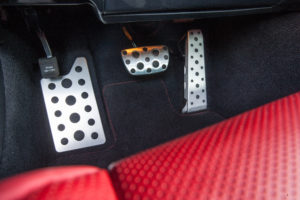
image courtesy Lexus
As with most sporty coupes, anybody you see in this back seat probably lost a coin toss. The RC F becomes, at best, a 3-person vehicle when I drive it. (A yogi might be comfortable behind me.) Both rear seat passengers get the same racy red leather seats, lights in the ceiling and cupholders embedded between the seats ahead of the armrests (covered in the picture below).
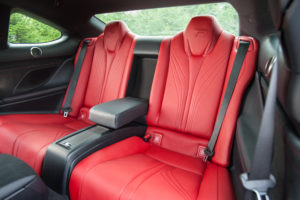
image courtesy Lexus
Hockey bag test
My bag fit nicely, with just a little compression, in the RC F’s trunk.
I lowered the rear seat armrest so I could feed my sticks through the rear seat pass-through, then closed the trunk with no problem. A grocery bag might fit to one side of the hockey gear, but that’s about the limit for this trunk.
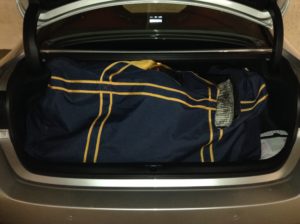
In-cabin technology
Sometimes, low-tech adds elegance. Consider the analog clock in the dash.
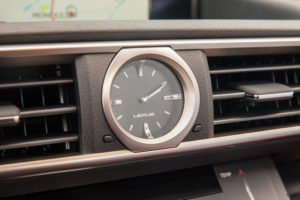
image courtesy Lexus
There’s an asymmetric instrument cluster in this car. The tachometer sits between a screen on the left and a smallish speedometer on the right.

image courtesy Lexus
The tachometer is also a screen. It changes appearance depending on whether you drive the car in Normal mode (above), Eco Mode or Sports Mode (below).
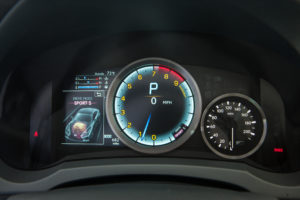
image courtesy Lexus
The screen on the left is where drivers choose settings using steering-wheel-mounted controls. I came to understand how to navigate these settings, but I found the interface too cluttered to interpret quickly. The G-force indicator (yes, there’s one of those) could be fun to check from time to time, but it shouldn’t be more prominent than the fuel gauge. (It’s a bar near the top of the screen.)
The designers of this instrument cluster could have used guidance from their counterparts in the infotainment screen department. This screen sits too far away to touch, so drivers must navigate the screen using a trackpad just behind the shift lever.
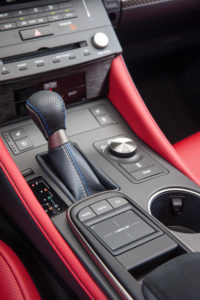
image courtesy Lexus
This system ought to be intuitive to anybody who has ever used a notebook computer. The mouse pointer, a bright dot, flashes when it connects with anything clickable on screen. The car emits a low-pitched “ding” when this happens. Click that object (by pressing the touchpad) and the car sounds a slightly higher-pitched “ding” while doing your bidding.
In designing this system, Lexus seems to have minimized the number of clicks required to do any specific operation. Three buttons, for Home, Menu and Back, sit just forward of this trackpad to reduce the need for clicks even more. (Towards the end of my week with the RC F, I found I was easily clicking the buttons I wanted without looking down.)
The fewer clicks the better, since Lexus jams plenty of electronic goodies into the RC F: navigation system; satellite radio; myriad settings; Bluetooth hookup for audio and phone. (The hard-wired crowd can use two USB and one aux input.)
This system isn’t without its flaws. After waiting several minutes for it to build a list of FM radio stations, I found that it stuck when scrolling through them. I also found myself longing for the good old days of analog dials, when I realized that the dial to the right lets you tune the radio. Thanks Lexus.
Audiophiles will appreciate the Mark Levinson premium audio system as it delivers music cleanly though 17 speakers.
Driving
I’m not sure if this car has more speakers or “F” badges (like the one on the engine cowl, below), but given the motoring experience, I’ll allow Lexus some excess vanity.
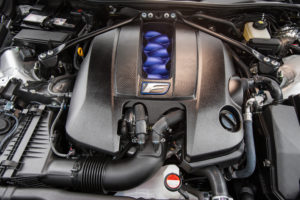
image courtesy Lexus
Hit the Start Engine button and the 5.0L V8 roars to life, ready to transmit up to 487 hp to the rear wheels. You can let the car handle the eight-speed Sports Direct Shift transmission or take over using steering-wheel-mounted paddle shifters. Whatever else you do, if you step on it, you will feel the acceleration.
You will also feel the braking. To keep drivers from getting into too much trouble, Lexus has added some serious stopping power in the form of ventilated disc brakes on all four wheels (larger-diameter discs at the front) featuring Brembo brake calipers, rotors and brake pads.
While in motion, active torque control, sport vehicle dynamics integrated management and other technologies collaborate to keep the car on the driver’s chosen path. The complete package handles all the acceleration drivers could legally want on public roads, and then some.
In my mind’s eye, I picture the NRFD crowd being reminded by their bosses to make room for a variety of non-racing safety driving technology. Radar cruise control, rain sensing wipers, blind spot monitor, rear cross-traffic alert and lane keep assist head the list of modern gadgets that drivers can use to keep the RC F safe from scuffs.
As previously mentioned, drivers can also choose to spice up performance in Sports mode. They can also tone down the car’s performance in Eco mode, or make it handle snow better at the push of a button. (I suppose the NRFD crowd had to bow to their masters on this one.)

image courtesy Lexus
Drivers who do get into difficulty can pop open the trunk. Lexus offers two small leather cases that stick to the trunk’s carpeted sides using Velcro: a first aid kit and the car’s documentation, including the manual.
Fuel
Do I need to talk fuel economy for a 5.0L V8 engine? No. I will say that the RC F takes 91-grade premium fuel in its 66-litre tank.
Pricing
Lexus sells the base RC F for $82,750 MSRP . With options, taxes and fees, my RC F totals $92,322.
Conclusions
Lexus aims the RC F at certain seemingly different markets. Consider: stiff sport seats offer air conditioning; a beastly motor kept in check on the highway thanks to adaptive cruise control. Lexus strives to please buyers of sports cars who want Lexus luxury. Does it work? Given how I miss the RC F already, and I haven’t yet returned it, I’d have to say it does.